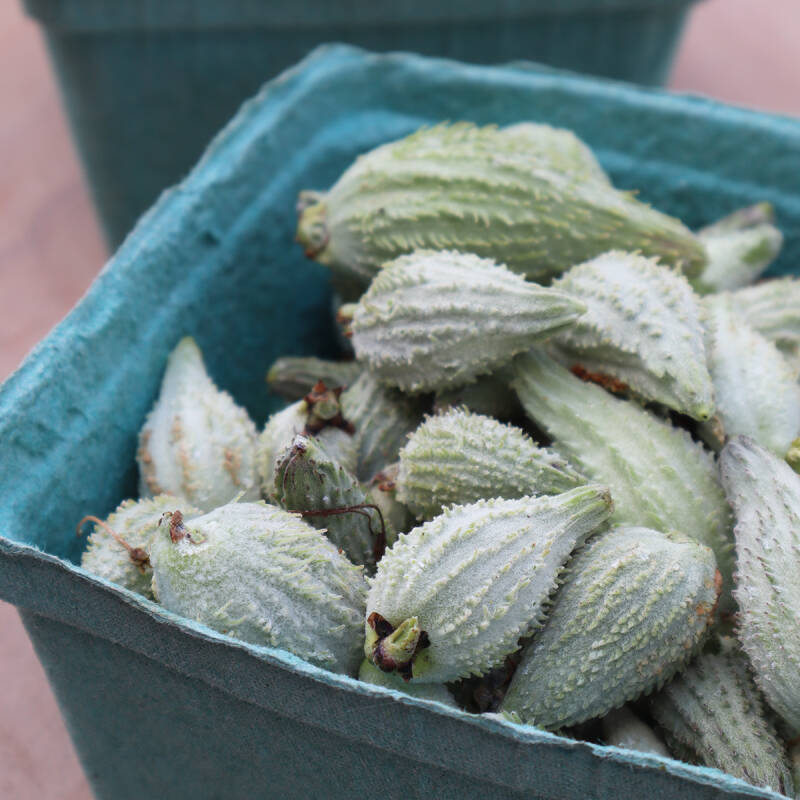My yard is filled with the rich scent of plants making their last stand. Lettuces allowed to go to seed are leafy columns waving small flowers like flags of surrender. The last of the summer sun fuels robust displays in my herb garden, especially from my basils, good soldiers to the end.
For a frozen cocktail recipe (made with the last of the summer’s basil), read on:
Photography by Laura Silverman for Gardenista.

Above: Sometimes called “the king of herbs,” basil actually can be a royal pain. With enough hot weather, it generally behaves like a hardy annual, but it wilts almost instantly in the refrigerator. This applies to all varieties, though the bushy, tiny-leaved pistou basil is a bit sturdier.

Above: Genovese basil, with its broad, crinkled green leaves, is perhaps the most familiar variety of Ocimum basilicum (Ocimum is from the Greek for “to smell”) but there are many others, including opal basil, Thai basil, holy basil, lemon basil…in all there are more than 40 cultivars and almost as many subtly distinct flavors.

Above: All basils belong to the Lamiaceae family of mints, so most have at least faint hints of that, but notes of anise, cinnamon, and clove are also common. This pungent herb is used extensively in Mediterranean cooking, but also in India, the country of its origin, and throughout Southeast Asia.

Above: There is no basil preparation more classic than pesto, the famous sauce from Genoa that contains just basil, garlic, and pine nuts pounded together, then mixed with olive oil and grated Parmesan. It’s traditionally made with a mortar and pestle, but a food processor makes a perfectly acceptable version.

Above: In addition to eating it fresh, I like to spread my pesto in a thin sheet and dry it thoroughly in my dehydrator (a low oven also works). Crumbled up, this newfangled garnish is delicious sprinkled on everything from rice and pasta to soup and salads, where it adds an irresistible crunch.

Above: The purple stems, flowers, and narrow deep green leaves of Thai basil all have a lovely sweet licorice undertone that perfectly complements the floral taste of fresh peaches. Gently poach them together in a bath of rosé sweetened with a little honey. The herb-infused syrup covers the fruit in a luxurious satin cloak.

Above: Chef Alex Raij taught me to make a Basil Pomada, the herbaceous, bright green frozen cocktail served at El Quinto Pino, one of four restaurants she co-owns in New York City. It comes together in just a few simple steps, starting with grinding together equal parts basil and sugar.

Above: This vivid paste is combined with lemon juice, water, and gin, then frozen in an ice cream maker until it achieves the perfect slushy consistency. (This kind of herb-flavored sugar is also wonderful in other cooking applications. Try using mint-sugar to bake chocolate biscuits.)

Above: No ice cream maker? No worries. Just place the mixture in a shallow glass bowl in your freezer and rake with a fork every 20 minutes or so until you achieve the right texture.
This divine concoction hails from the Spanish island of Menorca, where the living is, clearly, very easy. It’s the best way to send off summer.
Basil Pomada, Menorca Style
Adapted from chef Alex Raij
Serves 6
Ingredients:
- 1 packed cup fresh basil leaves
- 1 cup sugar
- 1 cup fresh lemon juice
- 3 cups water
- 12 ounces gin (preferably an herbaceous one, such as Plymouth)
Instructions:
Combine sugar and basil in a food processor and process until very finely ground.
Scrape basil-sugar into a small bowl and pour the lemon juice over. Set aside, stirring occasionally, until sugar melts, about 15 minutes. Then combine with water and gin in your ice cream maker, and run the machine until the pomada is slushy, similar to a frozen margarita. Pour into a rocks, highball, or margarita glass and garnish with a sprig of basil.
For more recipes from my garden, visit Glutton for Life. And for more on our favorite basil varieties, see our Field Guide posts on Tulsi Basil and Sweet Basil.
Finally, get more ideas on how to successfully plant, grow, and care for sweet basil with our Sweet Basil: A Field Guide.
Interested in other edible plants for your garden? Get more ideas on how to plant, grow, and care for various edible plants (including flowers, herbs and vegetables) with our Edible Plants: A Field Guide.








Have a Question or Comment About This Post?
Join the conversation